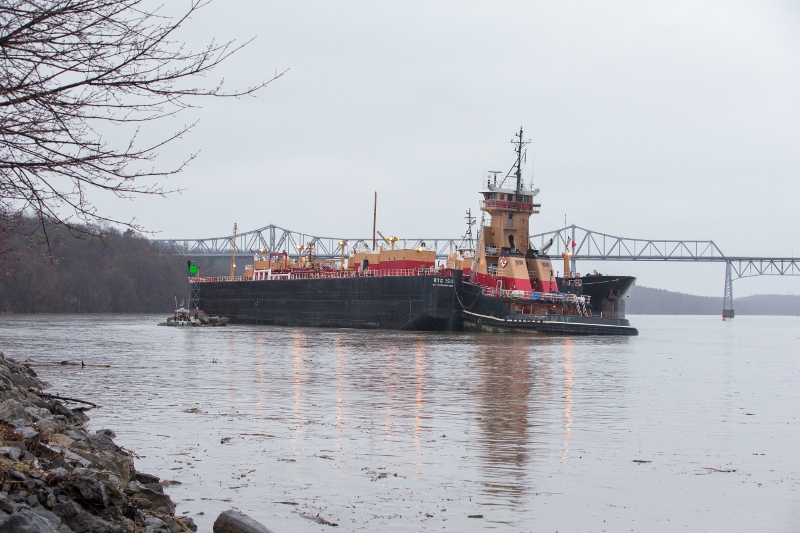The first images coming out of Coast Guard Sector New York on Tuesday grabbed attention all up and down the Hudson River: The sight of a 458’ articulated barge, grounded hard against a stone channel marker.
The double hull barge RTC 150 and its tug, the 119’x40’x22’, 7,200-hp Meredith C. Reinauer, were headed north toward Albany, carrying 60,000 bbl. of gasoline, when the ATB went aground on the west side of the channel just off the village of Catskill around 8:30 a.m.
Built in 2003, the ATB has a double hull as required under the Oil Pollution Act of 1990 — commonly known in the industry as OPA 90, the law Congress passed in reaction to the 1989 Exxon Valdez oil spill in Alaska.
It worked. The RTC 150 and Meredith C. Reinauer refloated on the night tide without damage to the tanks, and proceeded safely to Albany.

Barge RTC 150 hard aground on a Hudson River channel marker on April 4, 2017. Philip Kamrass/ Office of Governor Andrew M. Cuomo photo.
The Coast Guard is investigating — and New York Gov. Andrew Cuomo made a personal trip to inspect the scene and promised the state will conduct its own inquiry.
Was there fog? Sudden power loss? As it approached off Dutchman’s Landing Park, just south of the Rip Van Winkle Bridge, did someone fall asleep?
We shall see. One thing for sure is the incident will inflame debate over proposed new barge anchorages along the Hudson.
The Coast Guard is still considering a proposal for new designated anchorages along the river, in response to an industry request. In October 2015 the Coast Guard advised operators they could only anchor in the seven federally designated anchorages now charted.
The Maritime Association of the Port of NY/NJ appealed for more space, particularly over the more than 100 miles between Yonkers, just north of New York City, and Albany. There is growing traffic on the river, with Albany a link between petroleum coming from western states and East Coast refineries and end users.
That has riled environmental groups and riverside communities, who are loathe to see what Republican state Sen. Terrence Murphy calls a “parking lot for fuel barges.”
Those arguments will continue, but the Catskill incident is a marker of one important fact. OPA 90 and its double hull requirement has been a good investment for the industry and the nation.
Over 25 years, the ratio of oil products spilled by marine transportation fell from 16 gals. per 1 million gals. moved, to between 2 and 3 gals. per 1 million, according to Coast Guard statistics.
When there is a mishap, and the environment and neighboring communities get away clean, that proves the value. At the May 2016 ITS convention in Boston, American Waterways Operators president and CEO Tom Allegretti summed it up.
“Congress and the American public expect flawless safety performance…safety is our franchise to operate tugboats and barges.”





